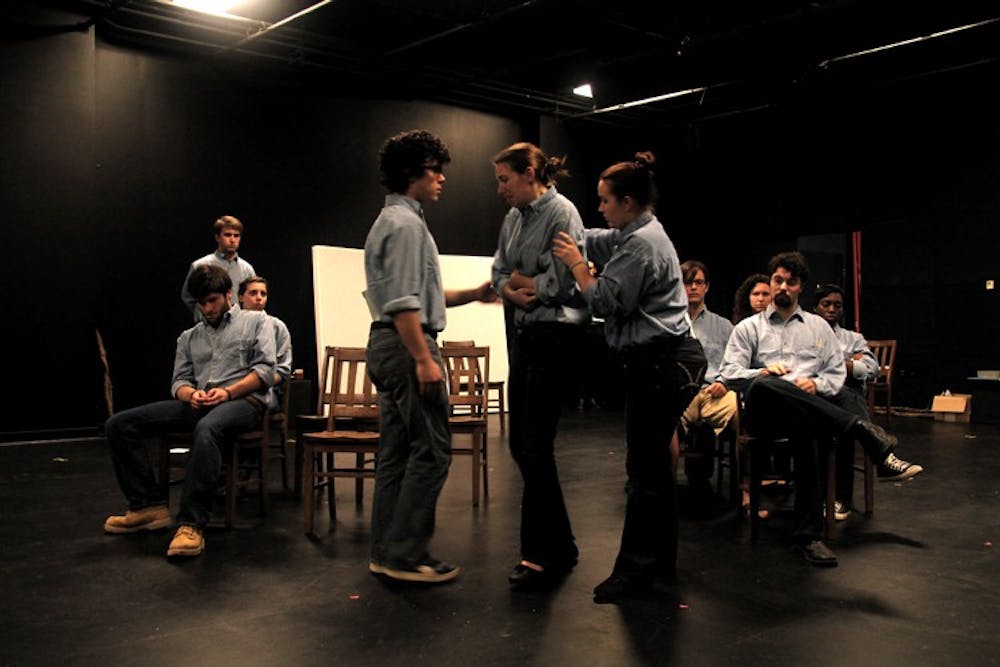When you perform a play about the death penalty, do you go for the brain or for the heart? The AU Department of Performing Arts’ production of “Dead Man Walking” decided to go for the simple solution: hit the audience in the gut.
It tells the story of Sister Helen Prejean, a nun who starts a correspondence with death row inmate Matthew Poncelet, who is seeking help to avoid his execution for the rape and murder of a teenage couple. The play is presented in conjunction with the Dead Man Walking School Theatre Project, of which AU is one of nine schools participating this season.
“Dead Man Walking” is a stage production of Tim Robbins’s award-winning screenplay of the same name. The AU production is set to run from Sept. 29 through Oct. 1 at Katzen Studio Theater.
Originally the AU performance of “Dead Man Walking” was meant to be a reading, consisting only of actors, scripts, chairs and music stands. However, Director Rick Hammerly saw a reading as a waste of the students’ talents and decided to turn it into a full production.
“I came in to cast it as a reading,” Hammerly said. “When we did a callback, one of the students said, ‘Could we memorize the lines?’ That’s when I decided to turn it into a production. I fell in love with these kids.”
Given only five weeks to prepare and a rather small budget, Hammerly had to improvise. He decided the main set element would be chairs and the actors would be responsible for everything from the soundtrack, to changing the set to lighting.
The finished production is very minimalist. The set consists of wooden chairs that the actors move throughout the play, as well as a white panel behind which the more gruesome action takes place, jail doors and some books and boxes. Hammerly emphasized the lighting elements that would define scene changes, as well as the strictly choreographed movements of the actors.
“I want it very simple,” Hammerly said. “Ours has a message so you want to highlight the text. If I cover it up with all movie stuff, it’ll get away from the message about the death penalty.”
The actors also all wear the same uniform: jeans, a blue shirt and dark shoes.
“When you make people wear the same thing, it makes them part of an ensemble,” Hammerly said. “It strips away age, ethnicity so you can buy into who they are. In terms of learning, this is a great way to focus on the characters and their emotional arc, rather than outside things.”
Hammerly, who co-founded the Factory 449 theater company and currently serves as its producing artistic director, said the students greatly impressed him.
“I didn’t expect as much from students because they’re just learning their craft,” Hammerly said. “They are dealing with the same professional challenges as actors would in my company. They were committed to the material, and in that way exceeded my expectations. I, as a professional actor, learned from them.”
The production is dedicated to the case of Troy Anthony Davis, a death row inmate who was executed Sept. 21. The beginning and end of the play feature recorded words by Davis and a photo slideshow of his life.’
School of Communication Assistant Professor Gemma Puglisi was in contact with Davis over the course of several years, and played a huge role in bringing the performance of “Dead Man Walking” to the AU campus.
Puglisi read about Davis in the newspaper and wanted to meet him. They regularly met in person for four years.
“I met him in October 2007, around the time he was supposed to be executed,” Puglisi said. “He wanted to share his story, wanted to get people to understand. I was so moved.”
Puglisi spent the next years writing to “celebrities, everybody and anybody who’d want to visit him.” She eventually got the Helen Prejean, on whose story “Dead Man Walking” is based, to visit Davis in Georgia. When they met in D.C., Prejean told Puglisi about the “Dead Man Walking” project and that she would love for AU to participate.
“I hope this play and the performance continue the extraordinary dialogue about how horrible the death penalty is,” Puglisi said. “[Davis] has created a movement, and I hope this movement continues after his death.”
Davis was sentenced to execution for the fourth time this month. Hammerly was hoping the sentence would be withdrawn as it had been previously. But it wasn’t and Davis was executed Sept. 21.
“I didn’t want to make the play a memorial to him,” Hammerly said. “I wanted it to tell his story, center it on the spirit with which he fought to maintain his innocence and fight against the death penalty.”
hbui@theeagleonline.com





